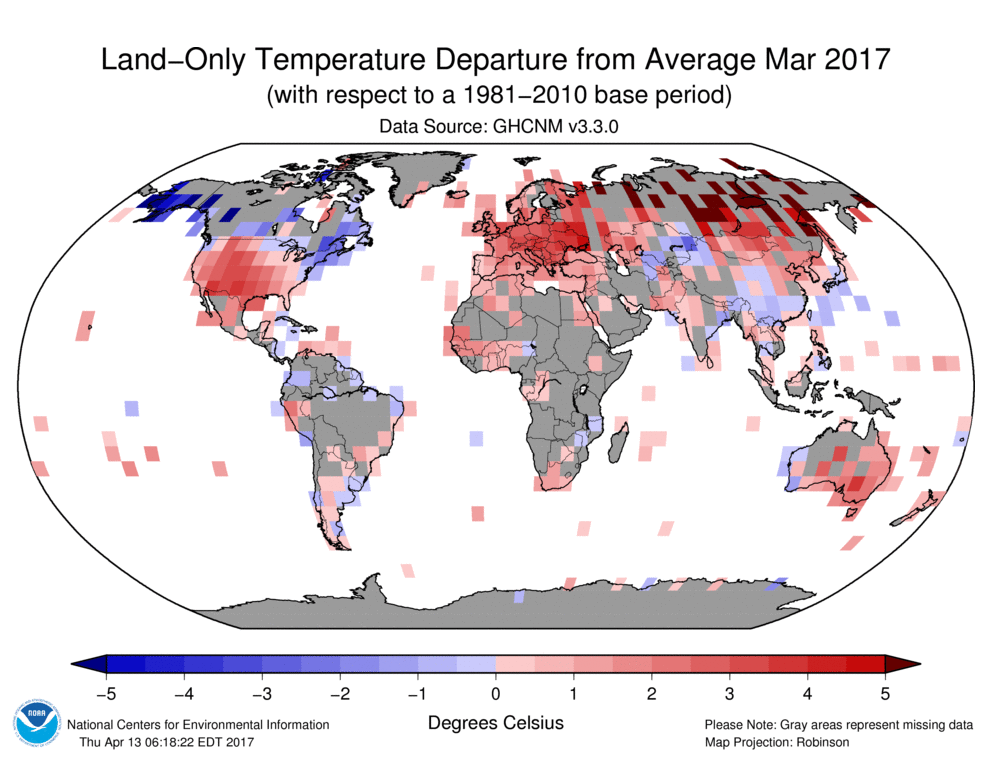Welcome to DU!
The truly grassroots left-of-center political community where regular people, not algorithms, drive the discussions and set the standards.
Join the community:
Create a free account
Support DU (and get rid of ads!):
Become a Star Member
Latest Breaking News
General Discussion
The DU Lounge
All Forums
Issue Forums
Culture Forums
Alliance Forums
Region Forums
Support Forums
Help & Search
Environment & Energy
Related: About this forumMarch 2017: 1st Time Ever Monthly Temps 1.8F Higher Than Avg. In The Absence Of El Nino
https://cdn-images-1.medium.com/max/800/1*boaBRhbUWlnujk8p8Z2Keg.jpegThe National Oceanic and Atmospheric Administration (NOAA) reported that last month set an unusual and unexpected new record for global warming. No month before March 2017 had ever exceeded the “normal” temperature (the 1981–2010 average) by a full 1.8°F (1.0°C) — “in the absence of an El Niño episode in the tropical Pacific Ocean.”
Why does this matter? An El Niño is “characterized by unusually warm ocean temperatures in the Equatorial Pacific.” El Niños generally lead to global temperature records, as the short-term El Niño warming adds to the underlying long-term global warming trend (see top chart).
So when a month sees record high global temperatures in the absence of an El Niño, that is a sign the underlying global warming trend is stronger than ever.
NOAA reports that both March and the year to date (January through March) were the “second warmest on record” for the world since global temperature records began in 1880. They were second only to 2016 which, of course, was a year marked by a major El Niño.
EDIT
https://thinkprogress.org/march-set-remarkable-global-warming-record-dfa2349c84c5
InfoView thread info, including edit history
TrashPut this thread in your Trash Can (My DU » Trash Can)
BookmarkAdd this thread to your Bookmarks (My DU » Bookmarks)
2 replies, 3736 views
ShareGet links to this post and/or share on social media
AlertAlert this post for a rule violation
PowersThere are no powers you can use on this post
EditCannot edit other people's posts
ReplyReply to this post
EditCannot edit other people's posts
Rec (4)
ReplyReply to this post
2 replies
 = new reply since forum marked as read
Highlight:
NoneDon't highlight anything
5 newestHighlight 5 most recent replies
= new reply since forum marked as read
Highlight:
NoneDon't highlight anything
5 newestHighlight 5 most recent replies
March 2017: 1st Time Ever Monthly Temps 1.8F Higher Than Avg. In The Absence Of El Nino (Original Post)
hatrack
Apr 2017
OP
OnlinePoker
(5,717 posts)1. I really question this because of how much data they don't have
Most of Africa and half of South America are extrapolated info. But, for instance, the northern region of South America shows cooler temperatures than average on the data points in the land-area only map below but has been extrapolated as mostly warmer than average on the land and sea map.

NickB79
(19,224 posts)2. I see in your graph they didn't include the Arctic, however
And other reports have been showing insanely high temperatures in that area all winter long.
Your graph also shows very little of the Pacific, and as we've seen from the continuing coral bleaching currently occurring, and the massive flooding in Peru, large portions of the Pacific are clearly warmer than normal.